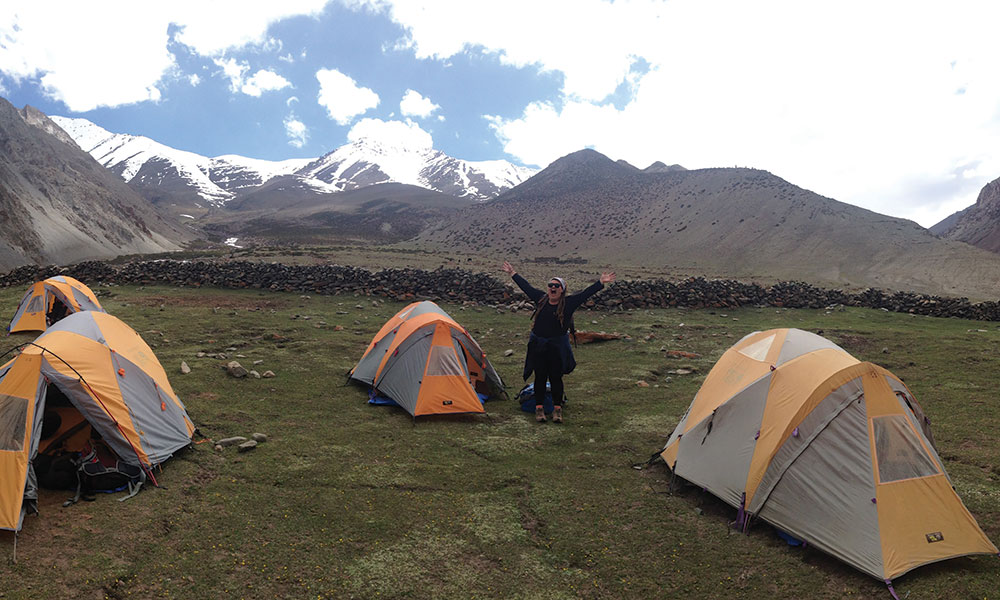I wake up to an orange glow and a knock on my tent door, if, indeed, one can actually “knock” on nylon. “Black tea?” I hear a voice ask. I quickly pull my knit hat up from over my eyes and unzip the door. “Yes, thank you,” I say, though, if I’m being honest, I don’t really like tea that doesn’t come in a bottle labeled “Snapple.” My tent-mate, Emma, wakes up too, and we sip on our teas together—surprisingly, it tastes amazing—and put off leaving the warmth (though “warmth” is a relative term) of our small orange dome for a short while longer. “OK, get up,” someone from the outside world says, a command we would come to hear regularly throughout the next few days, though the matter-of-fact tone in which it’s said—not irritably, not bossily—combined with the fact that all 22 of us wanted to “get up” exactly the same amount (not at all), made it more humorous than off-putting.
We emerge from our tent onto a valley floor. Our gazes rise up the valley walls to the snow-capped peaks surrounding us. A line of 20 or so ponies stand off to the side of our campsite, weighed down with bags and bundles of camping gear, and tired-looking college students emerge from a dozen or so other orange tents that are set up along our small grassy patch of ground. We cross a tiny stream that is starting to freeze around the edges and duck into a long, blue tent with a table and chairs inside. Breakfast.
OK, I admit it. This isn’t exactly the definition of “glamping” (glamorous camping). There was no king-sized bed in our tent, no luxury bathhouse across the valley floor, no space heater for when the temperature dropped below freezing. Then again, how many luxury glamping experiences can boast a different landscape every night for four nights, or a well-earned view from 16,000 feet? This trip was in a class all its own, and therefore, deserves a name all its own: “glampacking” (glamorous backpacking).

To back things up a little bit, this all happened the summer before my junior year of college. I had signed up (much to my mom’s alarm) for a faculty-led summer academic study trip to Ladakh, a region in northern India bordering Tibet, that included a week at the Students’ Educational and Cultural Movement of Ladakh (SECMOL), an alternative, eco-friendly school in the Indus Valley near Leh, in the Ladakh district, and a week trekking in the Indian Himalayas with Rimo Expeditions, which leads trips throughout the Himalayan and Karakorum Mountains. The trek was the main reason I signed up, and I expected it to be like the overnight backpacking trips I had taken with my dad: carrying 30-plus pound packs, eating ramen noodles cooked over the Svea camp stove my dad got when he was a Boy Scout in the ’60s and figuring out how to set up our tent, which we used only a few times a year. Turns out, I was a little off.
When our group got to the first campsite, after a long, treacherous bus ride and week spent at SECMOL, which only served vegetarian meals cooked with a solar-powered oven, we weren’t in great spirits. But upon walking into the “dining tent” (Seriously? This was high class!) and finding french fries, we perked right up. Throughout the five days we spent with Rimo Expeditions, which, besides arranging treks leads mountaineering, mountain biking and rafting trips, we ate well: chicken stir-fry, tomato soup and even a cake on our last night of the trek. (How they baked a cake in the middle of the Himalayas is beyond me.) Our bags and tents were carried by the ponies, who, along with a group of guides (including a few Sherpas), left camp early, dropped our lunch at a predetermined spot and set up our next campsite before we arrived.
Backpacking surely isn’t everyone’s idea of a perfect vacation—there’s certainly very little relaxing (unless one of your fellow hikers leads a group meditation session upon arriving at your campsite). But nothing beats the feeling of standing at the top of a mountain pass, one that very few people have ever stood on, knowing there’s a hot meal—that you don’t have to cook yourself—waiting for you at camp.


